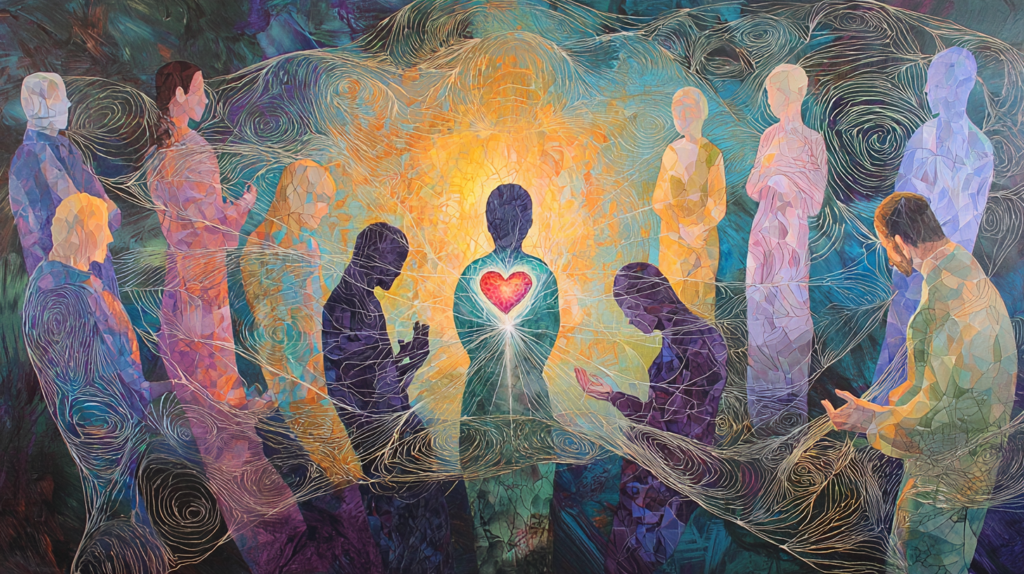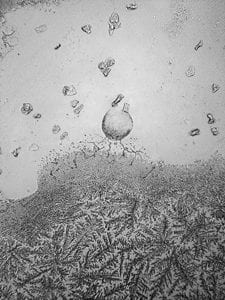
Trauma psychology - the most important thing to understand in our time?
When Psykologvirke opens the Trauma Center these days, we say with the mystic and poet Rumi: Your wound is the place where the light can pass through. And this applies to all of us. That is precisely why the understanding of trauma psychology so central to individual and collective healing.
An example: At the conclusion of a successful therapy session, a client shared his most important learning from the process: “Dare to look within!«
A touching change in a person who had developed the most intricate systems to avoid seeing, listening and feeling within. To the point where he had painted himself into just a slice of life. The therapy had instead taught her to face herself on the inside.
Upon termination, she stopped submitting the lottery ticket. She has already won the first prize by learning to relate to the deepest levels of herself. Since this is something that very few people know or have expertise in, she could now find gratitude for having been traumatized in the first place.
In and through the wound, she found herself, and was able to follow herself out into the world.
Trauma psychology that concerns us all
Mental disorders are a blanket term that includes very different conditions, all of which are so-called multifactorially determined. This means that there are many reasons that have come into play.
Of the subgroups I myself have encountered during my career, there is nevertheless a common feature that unites absolutely all of them, and - believe it or not - that also unites "psychologist" and "patient".
This common feature is that we have something lying on the inside which we cannot tolerate or dare to let go completely. Because we are afraid. We have primarily lost trust in ourselves and our own organism. Preferably after we once experienced that we could not be completely ourselves with others.
We fear hurting, and we fear being hurt. We fear the pain and loneliness. We fear the responsibility of having caused pain to others. We fear that there is something terribly wrong with us, that others will judge us for.
We learned to fear anything that threatened our ties to those closest to us. And that applies to all of us.
Living out of fear
As long as we have something inside ourselves that we fear, we will never be free. You can run, but you cannot hide. When the fearful material (memories, feelings, needs) approaches, we will become anxious. Then we either have to shut down or be overwhelmed.
When we become anxious, we will instinctively try to reduce the discomfort. We avoid the situation or use unconscious psychological defenses. The body is automatically armored against the reactions that would otherwise break through from the depths of the body.
Purely physical reactions, such as muscle tension, are designed to keep our reactions in check.
In addition, processes are initiated to take control of what the body was about to do. For example, that the attention is shifted to something else.
This often happens in combination with a so-called defensive feeling blocking. We don't get angry, but despair. We don't sob out the pain, we become choked with tears and ashamed and self-critical.
The first challenge is that there is a mental and physical override of the body's spontaneous and natural expression. We shut down and isolate bad feelings, memories and needs on the inside, and create distance and distance from ourselves, our loved ones and life.
This, as far as we understand, is broadly theoretically agreed upon and partly documented empirically through, for example, Barlow's Unified Protocol.
The second challenge is overwhelming. We are simply overwhelmed by anxiety or bodily symptoms when difficult memories, feelings, thoughts and needs are activated. Whether we are alone or with others. Either out of the blue or in predictable situations.
Research related to tolerance window supports the need to understand overwhelm and the need to build capacity to endure oneself, others and life.
The price we pay by protecting ourselves
In the short term, we avoid the feared. We managed to avoid showing who we are, letting go of the shame and potential for judgment and rejection. But this has resulted in a cost that is greater than we realize.
First and foremost, we pay the price in a currency of solitude.
We may end up with large continents on the inside where no other human has ever set eyes, ears or feet.
Of course, one's character springs in part from innate temperament, but it is also designed as an adaptation to the environment. We need our caregivers. We need the herd.
And this does not only apply to us. Our carers, friends, colleagues, neighbors and relatives also have their wounds. They do their very best, but the default is usually to reject, ignore or punish when someone behaves differently from what is safe and familiar.
So when we get the carer's and the pack's more or less conscious traumas and cultural programming straight in the face, most people will bend over and comply.
We choose to let go of something in ourselves. Culture trumps nature.
Why? Because our survival depends on our closest relationships. Anything that threatens relationships also threatens survival. Among other reasons, feelings, impulses and needs from within that threaten the bonds with those closest to you will create anxiety.
Loneliness at the heart of trauma
An independent reason is also that it is simply so terribly, terribly painful when the love shared by the child or the adult is not accepted, or is not reciprocated.
It hurts to be alone in everything that is difficult. When one's own reactions only make the pain worse. When you are unable to regulate yourself, but also have no one else to turn to.
When you can neither express nor properly suppress what you feel, need and want.
Affiliation trumps autonomy
The problem is that for survival we are dependent both on the connection to others, but also on being able to feel and follow our gut feeling. To be in touch with oneself and one's own instincts.
In the span between attachment and autonomy, attachment trumps. Years where adaptation to others has taken shape means that contact with ourselves ends up in the background. We no longer know what we feel, want and think. We are chained by self-doubt. We become a shadow of ourselves, or perhaps rather a shadow of others.
Bodily overwhelm
One of the challenges of having a body is that it works. This means that we sometimes notice that the body overrides the wishes of our egos. We would have liked to have stayed up longer, but we are dead tired. We don't want to blush, but our face is hot and red. We watch movies at the cinema, but the bladder is full. The body is far wiser than us, even if it doesn't always feel like it's playing on a team. This is particularly important when we work with the stress, anxiety or overwhelm that can be awakened when bad memories or emotions are activated.
For so many people, it feels like the body is doing something wrong, that it is working against us or that it is broken. We therefore work a lot on accepting the body's expressions such as true and correct. Considering we drank water before the cinema, it is true and correctly that we now have to go to the bathroom. Considering that we are insecure socially, it is true and correctly that we blush when we talk to others at a party. Considering our background, it is true and right that we are overwhelmed when we meet others, dream at night or are alone.
In trauma psychology, we focus on getting to know and understanding the body as a healthy and precise organism, which reacts exactly as it should. In this way, we avoid becoming unfriended with ourselves or the body when it does not behave as we would like. The next step is to work with the body and the brain, so we can gradually become safer and more secure in ourselves, together with others and in the world. Some experience a strong fear when meeting others, while others describe more of a bodily stress reaction without understanding why it is there. In any case, the key is to become safer.
The first step is to build capacity so that we are not overwhelmed, so that we are able to be present in situations and in our own body and brain. It's like building fitness, so we can jog a certain distance. The next step is to get comfortable, so we don't get unnecessary pain. It's like practicing technique, so your knees don't hurt when you jog this distance. The last step is to develop curiosity, creativity, playfulness and joy in dealing with yourself, others and life, so that you can experience challenges as meaningful and developing. It's like finding joy in jogging, discovering new routes to jog, getting a training buddy or taking part in a competition.
When we talk about the body here, we are thinking of both body and brain. Organism is therefore a slightly better expression, it encompasses all of our physiology.
The organism wants us well
But we must remember that the body – our organism – wants us well. It never gives us up. Until the day we die, the authentic part of us will continue to try to show itself. You just have to look and listen inside. It is important to learn to recognize the spontaneous signals.
Secondly, one must learn ways to override old programming, because when the authentic that has previously threatened connection rises, the anxiety will come, and then the avoidance and defenses will also come. For example, you become restless and restless, and start working on something to feel better.
The dynamics of trauma psychology
This is the very dynamic of compulsion, which is an essential part of trauma psychology. You don't have to check things a thousand times to be affected by a compulsive dynamic in your psyche. Checking behavior is just the prototypical expression of the same underlying dynamic:
We are forced to be a certain way, do certain things, feel certain things and think certain things. Or perhaps rather not being, doing, feeling and thinking certain things. We become unfree and get symptoms.
Automated mental and bodily checkpoints patrol the boundaries of the ego as carefully as it can, to protect us from what is difficult or has been dangerous earlier in life. In the long run, this affects not only how we feel, but also how we experience ourselves and others.
We constantly end up having our often fearful assumptions confirmed, and in any case do not get them disproved.
Updating such human software – and which at one time in the child's life seemed to be a matter of life and death – is no easy task. Then you have to hack deep into the algorithm - which is also invisible. Past programming, trauma, fear, mistrust, control. It is not simple.
But it is possible.
To surrender
For deep healing we simply have to give up, stop resisting, surrender, let go and accept, flow with reality as it is actually constantly flowing towards us, and through us. Up from the stomach, through the chest and out into the body, our feelings will. Who dares?
Who dares to look inward and step into the unknown. To open oneself up, fully and completely, to one's partner's criticism. To open up completely, to the discomfort in the body during an argument, hidden behind defense and counterattack?
If the discomfort could be allowed to pass undisturbed through the organism, how would it have moved? Emotions mean movement. Who dares to let the body move, rather than being the one who moves the body?
Who does not dampen the emotional movements in the body by rather holding on to the discomfort, rather thinking, rather shifting the focus out and away?
We must dare to see, hear and feel within. As the client encouraged us to do. At the wound, the light enters.
Mom and the truth
Sometimes I think that maybe this my old mother was referring to what she always told me growing up that the truth must be endured. And my old grandmother who easily biblically used to say that the truth sets you free.
Howard Thurman, student of Ghandi and mentor of Martin Luther King, said that we should not ask what the world needs, but what makes us come alive. Because what the world needs is more people waking up to life.
To properly awaken to life, we must step out of cultural programming and trauma. Overcome patterns of overcontrol and avoidance. Behind the mask and into the heart.
The founder of the therapeutic methodology Diamond Approach, AH Almaas reminds us of two things we need to reach the painful truth that often lies within: Trust and compassion.
This is the core of good trauma treatment.







